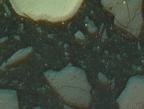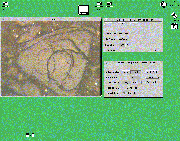
![]()
 |
|
|
| |
In the search for oil and gas, scientists look in rocks for organic matter called vitrinite. Careful analysis of vitrinite will tell whether the rocks have reached the right temperature range for hydrocarbons (oil and gas) to be present. Analyzing vitrinite normally takes 3 to 5 work days, but Roy Enrico and Robert Borger at Mobil Oil now use computer-based video and image analysis to get more accurate results in just 8 hours.
 �
�
Vitrinite grains indicate paleo-temperature and the presence of hydrocarbons, thereby predicting the possible presence of oil and gas.
![]()
In a specific temperature range and in the right conditions, organic material transforms to oil and gas. At higher temperatures, oil and gas break down to worthless carbon residue. So prospectors need a temperature indicator like vitrinite to tell them if oil and gas may be present. Derived from woody material, vitrinite is common in the sedimentary rocks that can hold hydrocarbons, and is an ideal temperature indicator. Robert Borger says, "It is a very valuable tool in basin evaluation. It can help you predict how much hydrocarbon is there." When vitrinite is heated, the carbon atoms reorganize and the vitrinite reflects more light. So scientists measure the amount of light relfected by vitrinite to determine the highest temperature ever reached in vitrinite-bearing rocks, looking for optimal temperatures for oil and gas.
Standard vitrinite analysis is a slow and labor-intensive process. The scientist must manually search for 100 vitrinite grains in each sample and measure reflectance on each grain. The process is prone to errors and inaccuracy, and analyzing a batch of samples takes 3 to 5 work days.
 �
�
After capturing vitrinite images, scientists analyze the images with image-processing software.
![]()
In the new process, a video camera attached to the microscope feeds video of a sample or reflectance standard through a Parallax Graphics XVideo card to the computer. The researcher captures high-resolution, 24-bit TrueColor images with up to 10 or 20 grains of vitrinite in each. The researcher then views a new area and captures a new image, repeating this process up to 10 times per sample to analyze at least 100 individual grains. XVideo supports the image resolution and quality required for accurate analysis.
After capturing the digital images, the scientist analyzes them with image processing software (WIT from Logical Vision, Ltd.). The software converts the RGB signal from each pixel to a measurement of light intensity. The reflectance standards relate light intensity to known reflectance values, so the software can create an equation converting light intensity to reflectance. The imaging software automatically picks out the vitrinite areas to analyze, trimming off the edges for accuracy. Each vitrinite grain shows up as hundreds of pixels, so that it produces hundreds of measurements instead of one, again increasing accuracy over the traditional method.
The new process is automated, making it faster, easier and greatly reducing the potential for human error. Comparisons of results of the new and old processes show that the new process is more accurate. Robert Borger reports that, "The results are repeatable. And the new method can be done quickly and inexpensively in-house, rather than sending it out to an external lab with additional time delays."
"We tried two other video cards first, but they never worked right. Then we tried Parallax." --Robert Borger, Mobil Oil
Building the system did not take much time once they had the right equipment. "We completed this project quickly and easily using off-the-shelf hardware and software", says Borger. "Adding the video part of it was easy once we had the right hardware vendor. We tried two other video cards first, but they never worked right. Then we bought Parallax. It has a reasonable price with the performance we need."
Robert Borger offers one tip for digital video users; "Make sure you have a good quality video camera. To get the highest quality images, you need the best video source you can get". Borger's project at Mobil uses a SONY 3-CCD video camera designed for stability and repeatability of color.
![]()
[ Home ] [ New! ] [ Products ] [ Solutions ] [ Support ] [ Company ] [ Contacts ]
Copyright 1997 Parallax Graphics, Inc. All rights reserved.